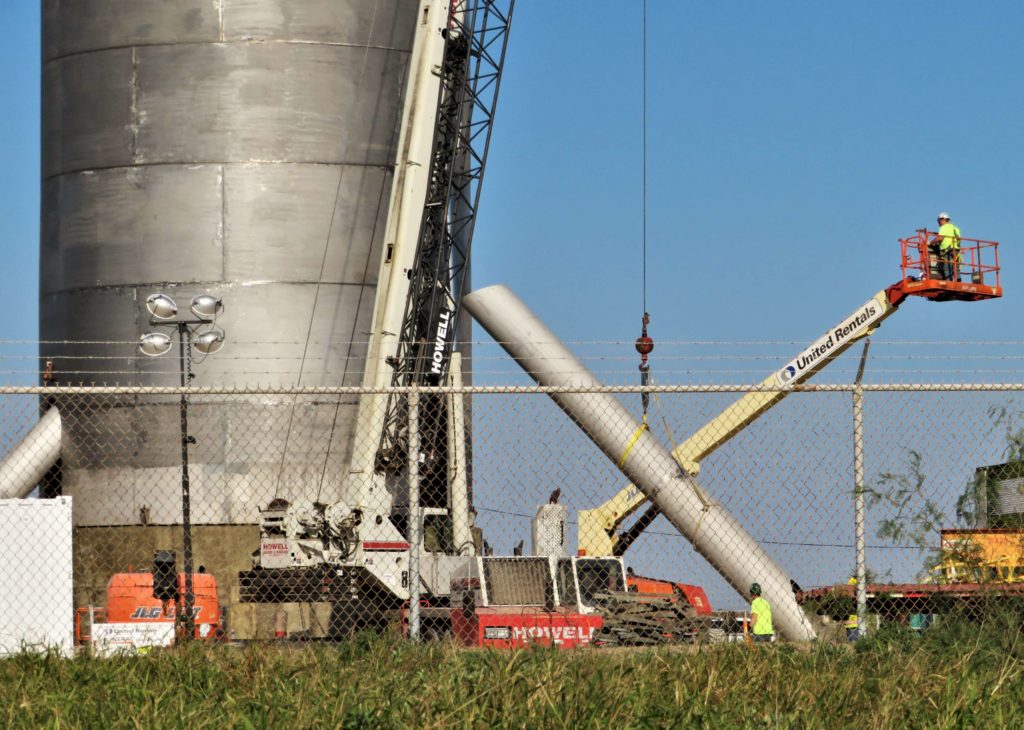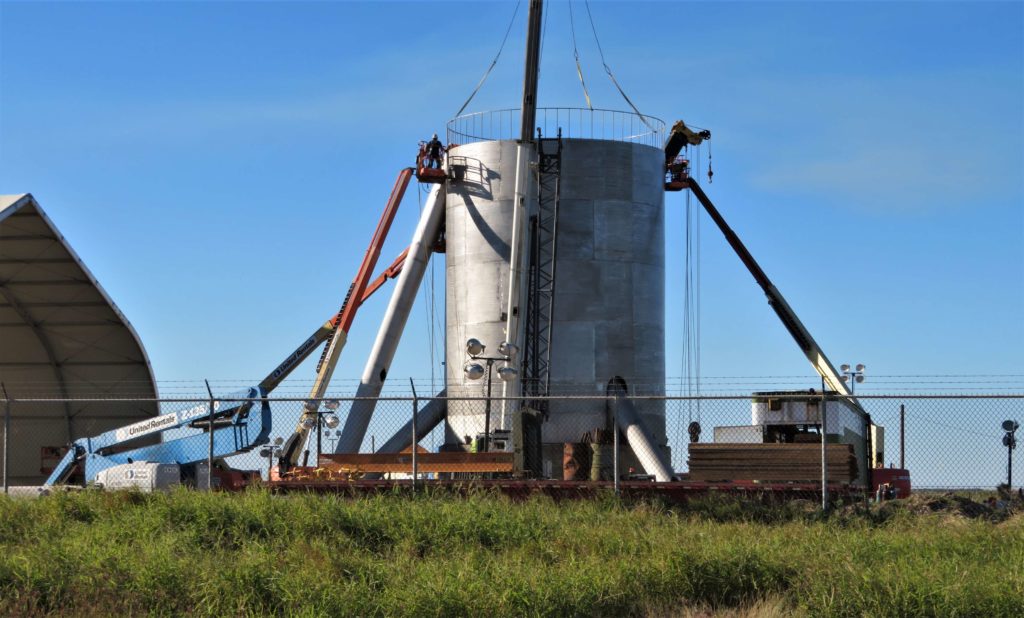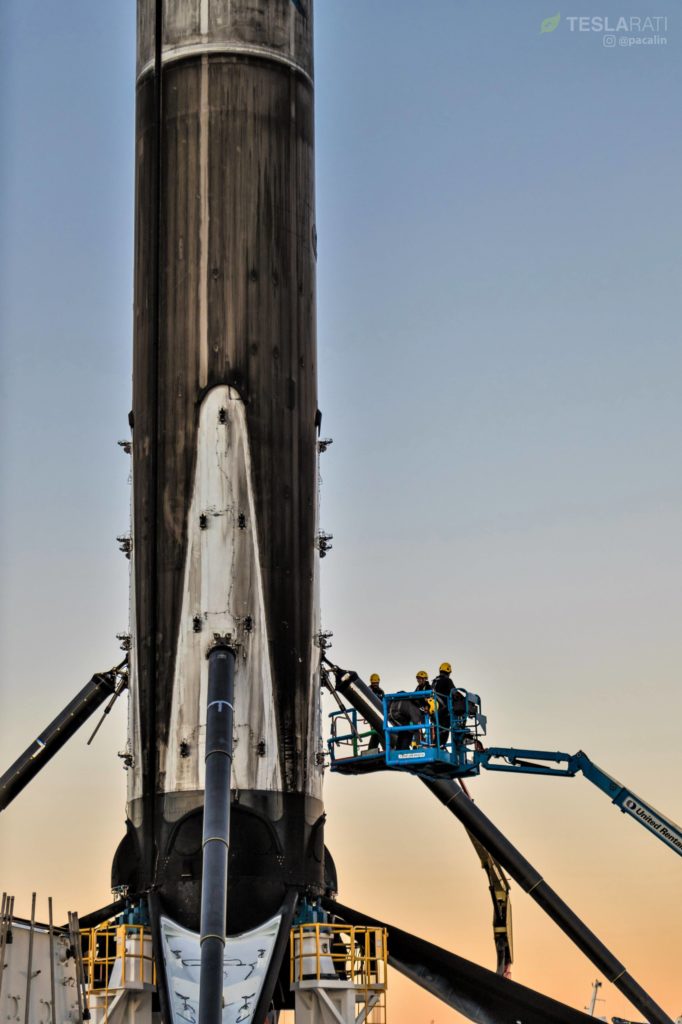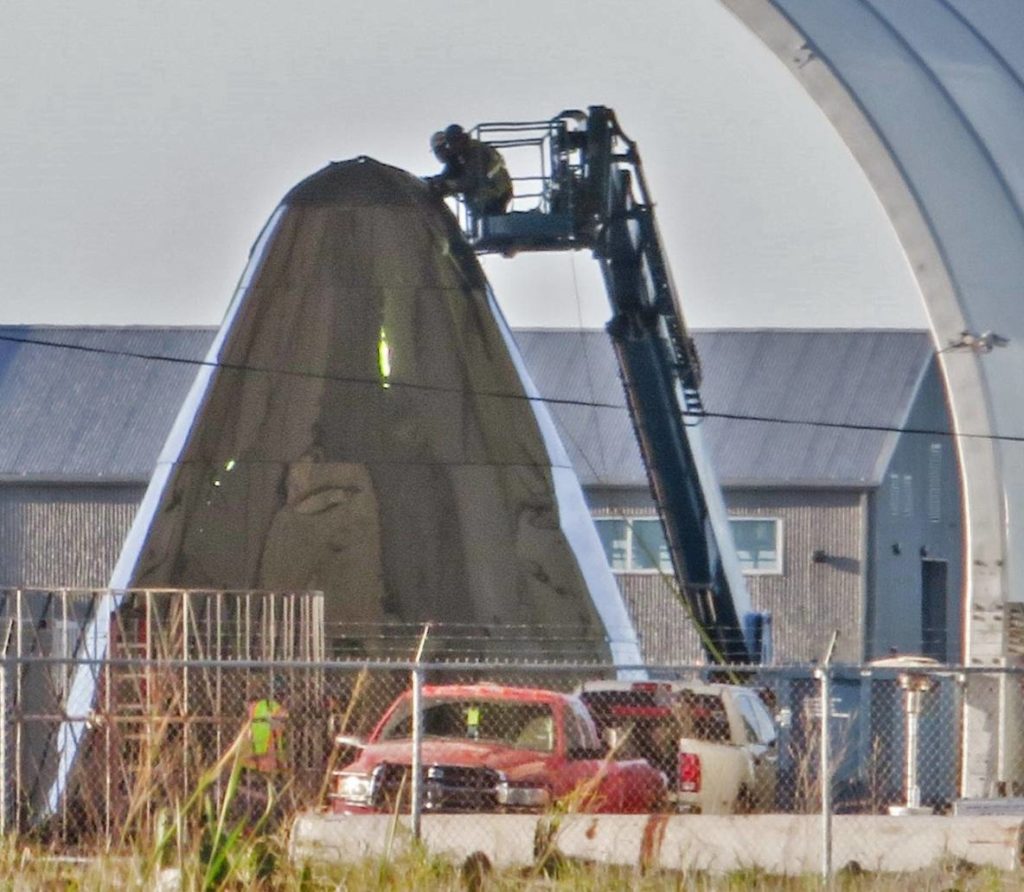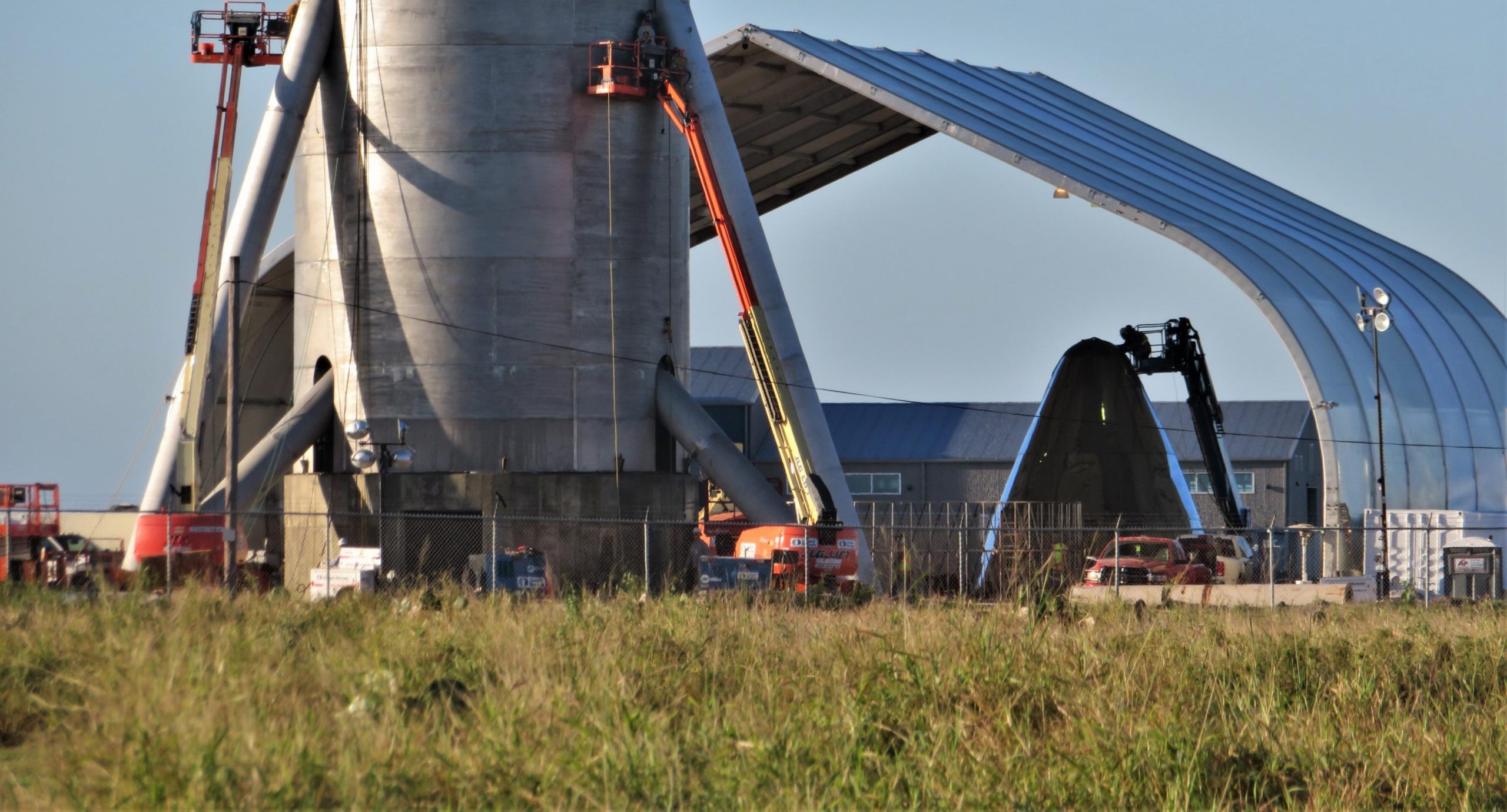
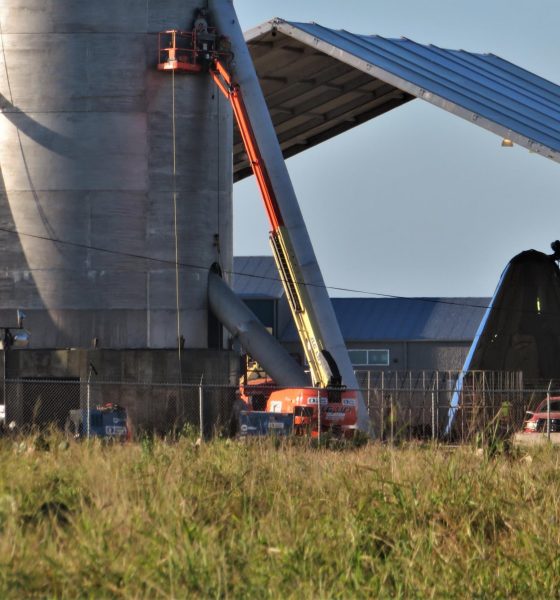
News
SpaceX CEO Elon Musk says Starship (BFS) hop tests could start in early 2019
SpaceX CEO Elon Musk has taken to Twitter to share an unexpected wealth of detail about the “radical” and largely unpublicized design changes the company’s Starship and Super Heavy (BFS & BFB) have undergone in 2018.
Beside information ranging from discussions of metallurgy to overall design philosophy and comparisons, the eccentric CEO also offered the most concrete target yet for the beginning of prototype spaceship (BFS/Starship) hop tests in South Texas – “March/April [2019]”.
I will do a full technical presentation of Starship after the test vehicle we’re building in Texas flies, so hopefully March/April
— Elon Musk (@elonmusk) December 22, 2018
On one hand, this expeditious new testing schedule – acknowledged by Musk himself to be “much sooner than expected” – is a thrilling prospect, given that it implies that a nearly full-scale prototype of Starship (or something vaguely approximating the spacecraft) could take its first baby steps into the air as early as the first quarter of 2019. On the other hand, however, this is an almost bafflingly large schedule change considering that SpaceX President and COO Gwynne Shotwell asserted that a prototype of BFS (now Starship) could begin “hopping” by late 2019, speaking in September 2018.
Shotwell: think we’ll be “hopping” the second stage of BFR (the BFS) late next year. #DARPA60
— Jeff Foust (@jeff_foust) September 6, 2018
Schedules (especially aerospace program schedules) do certainly tend to be chaotic and jumpy, but it’s almost inconceivable that any given project – regardless of the scope or scale – could wind up reaching completion nine months earlier than previously forecasted without suffering one or several dramatic compromises, typically involving lower-fidelity testing and prototypes or watered-down deliverables. It’s unclear if BFR has suffered the same fate, but – to put it lightly – the South Texas sight greeting the eyes of close followers of SpaceX’s BFR program is downright unbelievable.
BFWhat?!
Given the very recent and conspicuous additions of triangular appendages that look precisely like rudimentary fins and an obvious nose cone assembly, the only possible conclusion to draw from photos of SpaceX’s Boca Chica facilities taken in the last week or two is that the company (and/or contractors) are busy building something related to Starship. At least in these early stages, the… thing being built could be best described as what might come to mind if you asked an imaginative kid to build a full-scale sculpture of Tintin’s spaceship on a budget of maybe $500,000.
You got something to show us in Texas? pic.twitter.com/vBF0WwwIfF
— Robotbeat🗽 ➐ (@Robotbeat) December 22, 2018
More likely than not, this could be a case of things being more than they seem. To most, it may almost look like an elaborate prank, but that assumes that we know the full story and have a decent working understanding of aerospace prototyping. For the vast majority of us, that is simply not the case – what looks like a spade is probably not a spade.
At the end of the day, the most basic of observations – that this purported ‘Starship prototype’ will begin hop tests with extraordinarily powerful Raptor engines installed as few as three months from now – suggest that this spooky metal contraption will be used to conduct the most basic of Starship tests. As such, it will probably never travel much faster than Falcon 9’s Grasshopper and F9R predecessors, which tended to gently accelerate from the ground to as high as a kilometer or two before slowly heading back down for a powered landing.
- What now seem to be extremely rough fin outlines were welded to the main steel cylinder like giant metal straws. (bocachicagal – NASASpaceflight)
- ¯\_(ツ)_/¯ (bocachicagal – NASASpaceflight)
- SpaceX recovery technicians work on Falcon 9 with similar cherry-picker lifts, offering a sense of scale of the new Starship water tower. (Pauline Acalin)
- A conspicuous nosecone appears to have arisen inside SpaceX’s new Boca Chica tent, adjacent to what looks like a water tower with tube legs. (bocachicagal – NASASpaceflight)
- (bocachicagal – NASASpaceflight)
Given that SpaceX has already refined this complex and challenging task to a reliable science with Falcon 9 and Merlin 1D, it’s unclear why a very similar test campaign would be of serious value to the company without simultaneously testing full-fidelity control surfaces (fins), exotic new stainless steel propellant tank technologies, and more. Perhaps SpaceX just really wants to ensure that Starship will be capable of landing and taking off from an unprepared and angled surface of the type it could (will?) experience on Mars. Maybe the company simply wants to have a bare-minimum flying platform capable of testing and refining multi-engine configurations of Raptor.
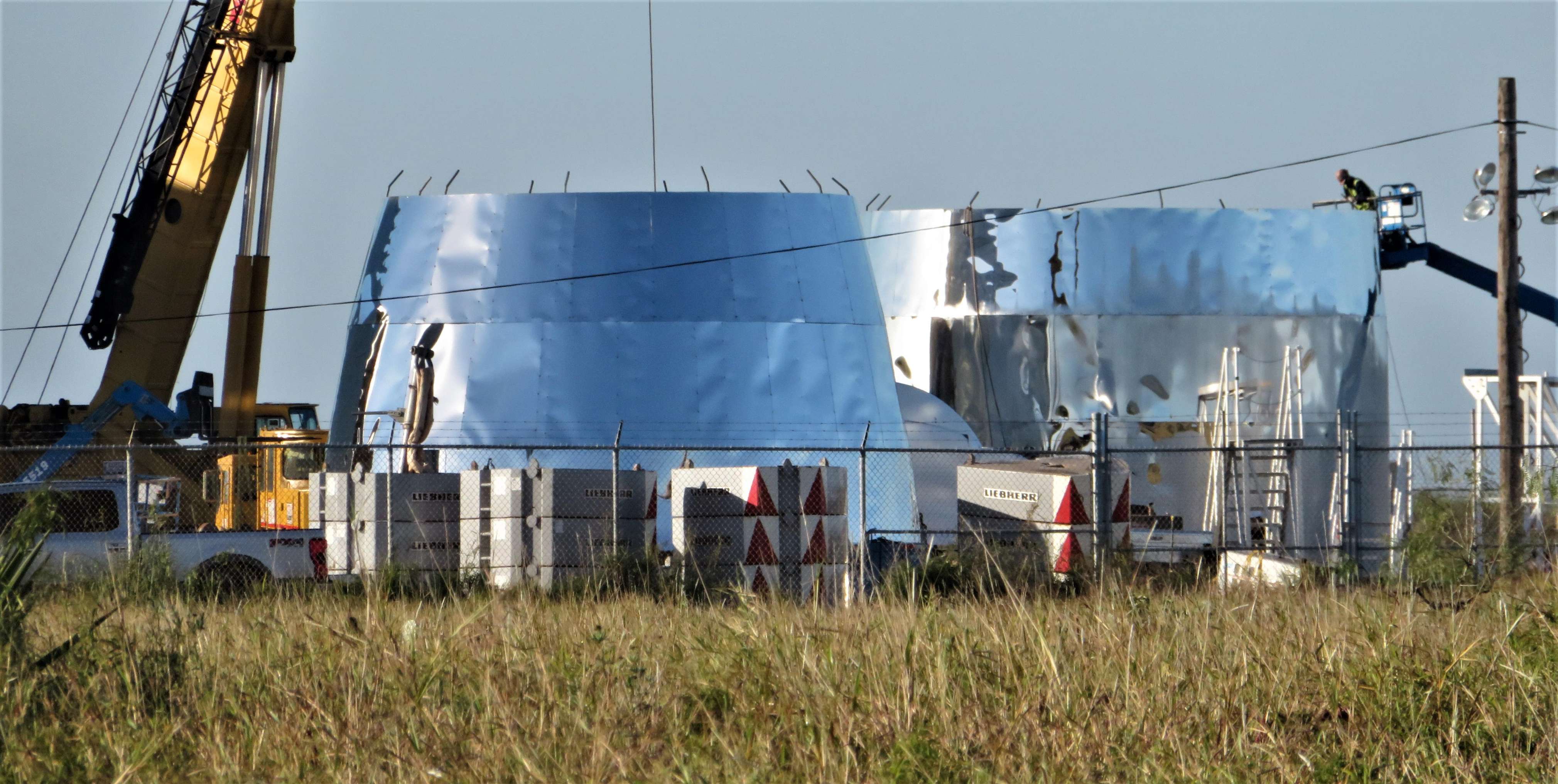
All that can be said for sure at the moment is that the public simply does not have the full story to explain the moderately shocking activity going on in Boca Chica. Musk did state that he would provide another technical update on the status of Starship and the BFR program as a whole in the first half of 2019, but only after the first Starship hopper flights have begun. It would seem that those on the sidelines will simply have to wallow in confusion and wild speculation for another ~3-4 months at minimum, hopefully only going moderately insane as a result.
In the meantime, copious thanks are owed to NASASpaceflight members bocachicagal and Nomadd for their relentless and thorough coverage of SpaceX’s activities in the obscure far south of the Texan coast, as well as their courteous permission for media outlets like Teslarati to republish their photos. Cheers!
For prompt updates, on-the-ground perspectives, and unique glimpses of SpaceX’s rocket recovery fleet check out our brand new LaunchPad and LandingZone newsletters!

News
Tesla is not sparing any expense in ensuring the Cybercab is safe
Images shared by the longtime watcher showed 16 Cybercab prototypes parked near Giga Texas’ dedicated crash test facility.

The Tesla Cybercab could very well be the safest taxi on the road when it is released and deployed for public use. This was, at least, hinted at by the intensive safety tests that Tesla seems to be putting the autonomous two-seater through at its Giga Texas crash test facility.
Intensive crash tests
As per recent images from longtime Giga Texas watcher and drone operator Joe Tegtmeyer, Tesla seems to be very busy crash testing Cybercab units. Images shared by the longtime watcher showed 16 Cybercab prototypes parked near Giga Texas’ dedicated crash test facility just before the holidays.
Tegtmeyer’s aerial photos showed the prototypes clustered outside the factory’s testing building. Some uncovered Cybercabs showed notable damage and one even had its airbags engaged. With Cybercab production expected to start in about 130 days, it appears that Tesla is very busy ensuring that its autonomous two-seater ends up becoming the safest taxi on public roads.
Prioritizing safety
With no human driver controls, the Cybercab demands exceptional active and passive safety systems to protect occupants in any scenario. Considering Tesla’s reputation, it is then understandable that the company seems to be sparing no expense in ensuring that the Cybercab is as safe as possible.
Tesla’s focus on safety was recently highlighted when the Cybertruck achieved a Top Safety Pick+ rating from the Insurance Institute for Highway Safety (IIHS). This was a notable victory for the Cybertruck as critics have long claimed that the vehicle will be one of, if not the, most unsafe truck on the road due to its appearance. The vehicle’s Top Safety Pick+ rating, if any, simply proved that Tesla never neglects to make its cars as safe as possible, and that definitely includes the Cybercab.
Elon Musk
Tesla’s Elon Musk gives timeframe for FSD’s release in UAE
Provided that Musk’s timeframe proves accurate, FSD would be able to start saturating the Middle East, starting with the UAE, next year.

Tesla CEO Elon Musk stated on Monday that Full Self-Driving (Supervised) could launch in the United Arab Emirates (UAE) as soon as January 2026.
Provided that Musk’s timeframe proves accurate, FSD would be able to start saturating the Middle East, starting with the UAE, next year.
Musk’s estimate
In a post on X, UAE-based political analyst Ahmed Sharif Al Amiri asked Musk when FSD would arrive in the country, quoting an earlier post where the CEO encouraged users to try out FSD for themselves. Musk responded directly to the analyst’s inquiry.
“Hopefully, next month,” Musk wrote. The exchange attracted a lot of attention, with numerous X users sharing their excitement at the idea of FSD being brought to a new country. FSD (Supervised), after all, would likely allow hands-off highway driving, urban navigation, and parking under driver oversight in traffic-heavy cities such as Dubai and Abu Dhabi.
Musk’s comments about FSD’s arrival in the UAE were posted following his visit to the Middle Eastern country. Over the weekend, images were shared online of Musk meeting with UAE Defense Minister, Deputy Prime Minister, and Dubai Crown Prince HH Sheikh Hamdan bin Mohammed. Musk also posted a supportive message about the country, posting “UAE rocks!” on X.
FSD recognition
FSD has been getting quite a lot of support from foreign media outlets. FSD (Supervised) earned high marks from Germany’s largest car magazine, Auto Bild, during a test in Berlin’s challenging urban environment. The demonstration highlighted the system’s ability to handle dense traffic, construction sites, pedestrian crossings, and narrow streets with smooth, confident decision-making.
Journalist Robin Hornig was particularly struck by FSD’s superior perception and tireless attention, stating: “Tesla FSD Supervised sees more than I do. It doesn’t get distracted and never gets tired. I like to think I’m a good driver, but I can’t match this system’s all-around vision. It’s at its best when both work together: my experience and the Tesla’s constant attention.” Only one intervention was needed when the system misread a route, showcasing its maturity while relying on vision-only sensors and over-the-air learning.
News
Tesla quietly flexes FSD’s reliability amid Waymo blackout in San Francisco
“Tesla Robotaxis were unaffected by the SF power outage,” Musk wrote in his post.

Tesla highlighted its Full Self-Driving (Supervised) system’s robustness this week by sharing dashcam footage of a vehicle in FSD navigating pitch-black San Francisco streets during the city’s widespread power outage.
While Waymo’s robotaxis stalled and caused traffic jams, Tesla’s vision-only approach kept operating seamlessly without remote intervention. Elon Musk amplified the clip, highlighting the contrast between the two systems.
Tesla FSD handles total darkness
The @Tesla_AI account posted a video from a Model Y operating on FSD during San Francisco’s blackout. As could be seen in the video, streetlights, traffic signals, and surrounding illumination were completely out, but the vehicle drove confidently and cautiously, just like a proficient human driver.
Musk reposted the clip, adding context to reports of Waymo vehicles struggling in the same conditions. “Tesla Robotaxis were unaffected by the SF power outage,” Musk wrote in his post.
Musk and the Tesla AI team’s posts highlight the idea that FSD operates a lot like any experienced human driver. Since the system does not rely on a variety of sensors and a complicated symphony of factors, vehicles could technically navigate challenging circumstances as they emerge. This definitely seemed to be the case in San Francisco.
Waymo’s blackout struggles
Waymo faced scrutiny after multiple self-driving Jaguar I-PACE taxis stopped functioning during the blackout, blocking lanes, causing traffic jams, and requiring manual retrieval. Videos shared during the power outage showed fleets of Waymo vehicles just stopping in the middle of the road, seemingly confused about what to do when the lights go out.
In a comment, Waymo stated that its vehicles treat nonfunctional signals as four-way stops, but “the sheer scale of the outage led to instances where vehicles remained stationary longer than usual to confirm the state of the affected intersections. This contributed to traffic friction during the height of the congestion.”
A company spokesperson also shared some thoughts about the incidents. “Yesterday’s power outage was a widespread event that caused gridlock across San Francisco, with non-functioning traffic signals and transit disruptions. While the failure of the utility infrastructure was significant, we are committed to ensuring our technology adjusts to traffic flow during such events,” the Waymo spokesperson stated, adding that it is “focused on rapidly integrating the lessons learned from this event, and are committed to earning and maintaining the trust of the communities we serve every day.”
